To make any room pop with stunning batik patterns, start by selecting a vibrant focal fabric that resonates with you. Use batik for accent pillows, throws, or curtains to infuse warmth and color. Mixing batik with solid-colored textiles creates balance and highlights those intricate designs. Think outside the box; consider batik table runners or wall art to draw attention. Layering different textures enhances the richness of your decor. Remember, the key lies in variety and coordination. Once you embrace these ideas, you'll discover even more inspiring ways to elevate your space beautifully.
Key Takeaways
- Use batik accent pillows and throws to introduce vibrant colors and texture, creating inviting focal points in living spaces.
- Incorporate batik table runners and mats for a lively dining experience, enhancing the ambiance with seasonal decor changes.
- Create striking wall displays with large batik fabric panels or framed pieces to transform blank walls into eye-catching features.
- Mix batik patterns with solid colors and natural fibers to balance vivid designs and enhance the overall aesthetic.
- Layer batik textiles with other materials to add depth and dimension, resulting in a rich and inviting atmosphere.
Understanding Batik Patterns
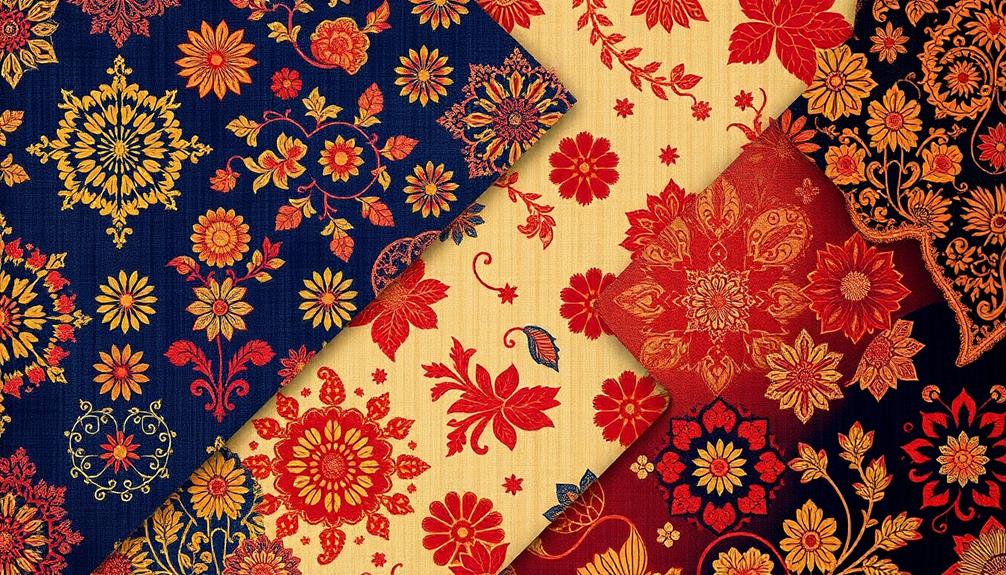
When you immerse yourself in the world of batik patterns, you'll quickly discover a fascinating blend of artistry and tradition. These stunning designs are crafted through a wax-resist dyeing technique that allows for intricate designs and vibrant colors, making each piece visually striking.
The term "batik" comes from the Javanese word "bathikan," meaning drawing or mark-making, which highlights the creativity and craftsmanship involved in this art form. Additionally, you can find beautiful Indonesian decor masks that reflect the rich cultural heritage and artistry akin to batik.
Batik patterns often carry cultural significance, symbolizing social status, nature, and virtues. This adds a layer of meaning when you incorporate them into your decor. You'll find various types of batik, such as Batik Tulis (hand-drawn) and Batik Cap (stamped), each showcasing different levels of intricacy and production speed.
Contemporary batik designs have evolved, merging traditional elements with modern aesthetics. This fusion makes these patterns suitable for various interior styles, appealing to a broad audience.
Whether you prefer the intricate designs of traditional batik or the fresh appeal of contemporary versions, you can find an option that resonates with your taste and enhances any space.
Choosing the Right Batik Fabrics

Selecting the right batik fabrics can transform your space into a vibrant reflection of your personal style. Start your fabric selection process by choosing a focal fabric that resonates emotionally with you. This fabric will guide the overall design and color choices for your project.
Aim to include a variety of batik colors and patterns, ranging from bold to subtle, to enhance your room's visual impact while maintaining a cohesive look. Additionally, consider incorporating Indonesian decorative pillows to further enrich the aesthetic and comfort of your space.
When it comes to complementary fabrics, consider fat quarters in dominant colors that contrast with your focal fabric. This creates depth and interest in your design.
Don't underestimate the power of large pieces of batik fabric; they help maintain the integrity of intricate designs, showcasing the beauty of the fabric effectively in your decor.
In your quilt design, play with asymmetrical layouts and alternative block sizes to add dynamic visual interest. This approach will keep your patterns from feeling repetitive, allowing the vibrant patterns of your chosen batik fabrics to shine through.
Creative Ways to Use Batik
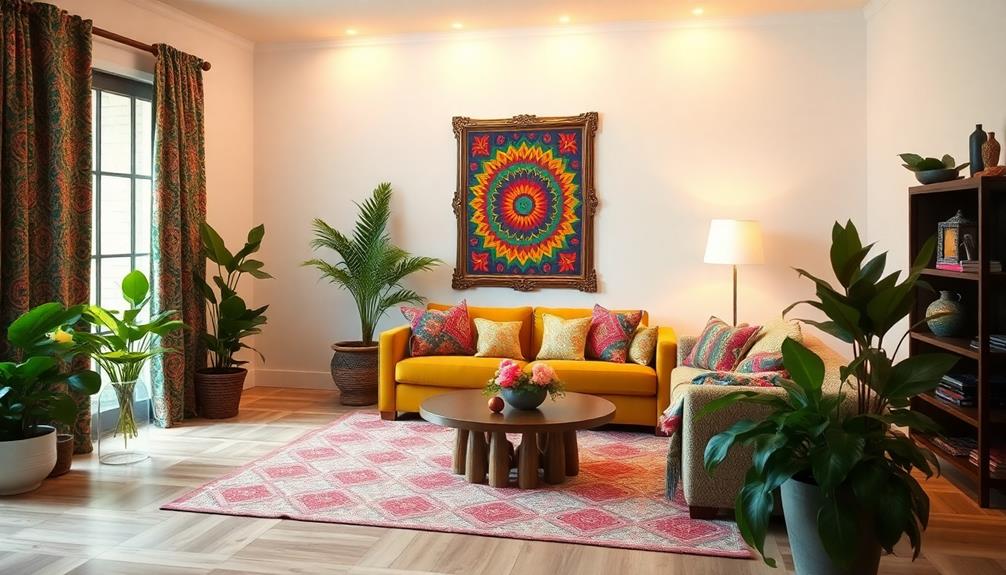
You can easily bring batik's vibrant energy into your home with accent pillows and throws that add color and texture to your living space.
Consider using batik table runners and mats to make your dining area pop during gatherings.
Additionally, incorporating a Face Indonesian Decor Mask can enhance the cultural richness of your decor.
Plus, showcasing batik wall art can transform your blank walls into stunning focal points that reflect your unique style.
Accent Pillows and Throws
Batik accent pillows and throws can instantly transform your living space, infusing it with vibrant colors and bold patterns that reflect your personal style. These decorative textiles not only serve as beautiful accents but also represent the rich cultural heritage of Indonesia, much like the importance of Indonesian decor masks.
To enhance the visual appeal of your room, consider mixing batik fabrics with contrasting designs. This dynamic combination on your sofa or bed creates an eye-catching focal point, allowing for easy seasonal updates without a complete room overhaul.
Choose batik patterns that complement your existing decor elements. Coordinating these pillows and throws with solid color backgrounds or other textiles guarantees a cohesive look that ties your space together. Batik throws serve as both functional and decorative pieces, adding texture and warmth while showcasing the intricate craftsmanship of the fabric.
To create an eclectic arrangement that draws attention, opt for a mix of different batik patterns and sizes in your accent pillows. This harmonious blend encourages conversation and adds a unique flair to your decor.
Table Runners and Mats
Transforming your dining experience is easy with batik table runners and mats that bring vibrant colors and intricate patterns right to your table.
These stunning batik fabrics can elevate your dining space, making them a focal point that enhances the overall aesthetic. Incorporating elements of traditional Indonesian style home decor can further enhance the ambiance, as natural materials and harmonious designs complement the beauty of batik.
Here are some creative ways to use batik table runners and mats:
- Seasonal Decor: Switch up your table runners to match the seasons. Bright, bold colors for summer or warm, earthy tones for fall can create a fresh ambiance.
- Customized Sizes: Tailor your table runners to fit your dining table perfectly, ensuring a cohesive look that complements your furnishings.
- Layering Textures: Combine batik table mats with other materials to add depth and interest, showcasing the unique designs of batik art.
- Themed Dinner Parties: Use batik patterns that reflect your party theme, making your table setting both inviting and stylish.
With these batik table runners and mats, you can effortlessly create a vibrant atmosphere that resonates with your personal style, turning every meal into a delightful experience.
Wall Art Displays
Elevating your home decor with batik wall art can create a striking visual impact that draws the eye and sparks conversation. Batik wall art serves as a vibrant focal point in any room, showcasing patterns that reflect cultural heritage and artistic expression.
To make a bold statement, consider using large batik fabric panels as wall hangings. They can transform a blank wall into a stunning display of color and texture, reminiscent of traditional Balinese motifs and patterns in decor traditional Balinese motifs.
For a more eclectic approach, incorporate framed batik pieces, whether vintage or contemporary, to create a gallery wall effect. This adds depth and visual interest to your space, inviting admiration from guests.
You can also experiment with mixed media art by combining batik prints with elements like wood or metal. This unique approach highlights the intricate designs while adding a modern twist.
Additionally, wall-mounted panels or quilts featuring batik can soften hard surfaces, making your home feel warmer and more inviting.
Mixing Batik With Other Textiles
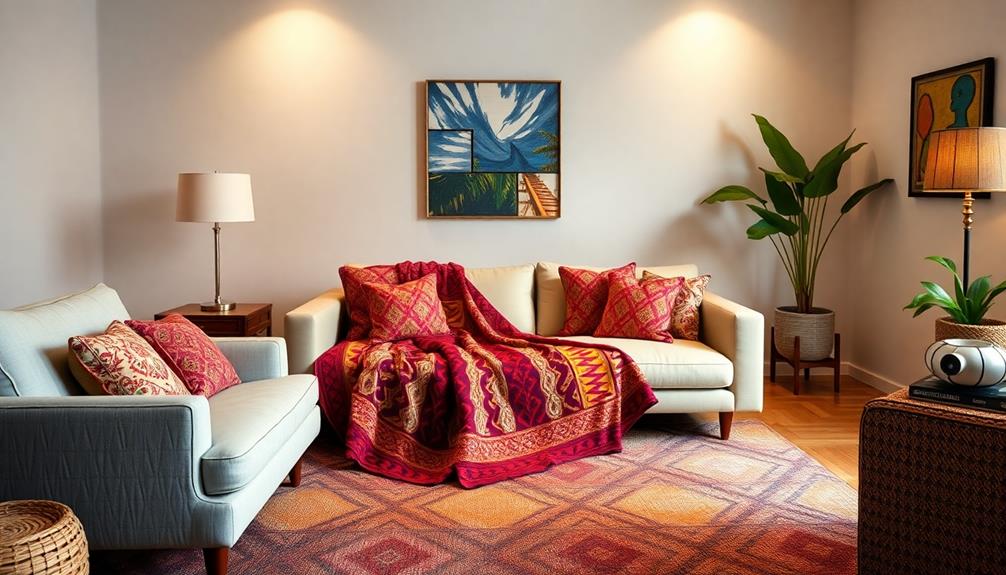
When you mix batik with other textiles, you create a mesmerizing visual experience that enhances any space.
The vibrant designs of batik fabrics can be beautifully complemented by integrating them with various materials, much like the expert consultation offered by Mahallati Interior in creating tropical living spaces.
Here are some effective ways to combine batik with other textiles:
- Solid Colors: Use solid-colored fabrics to balance the vivid patterns of batik. This creates visual harmony without overwhelming the overall effect.
- Complementary Materials: Incorporate batik with linen or cotton to enhance the aesthetic. These fabrics allow the intricate batik designs to take center stage.
- Layering Textures: Layer batik textiles with different textures, like velvet or burlap. This adds depth and dimension, making your space feel more inviting.
- Accent Pieces: Use batik as accent pieces, such as cushion covers or throw blankets. Pair them with neutral or muted fabrics to let those colorful patterns pop.
Care and Maintenance of Batik
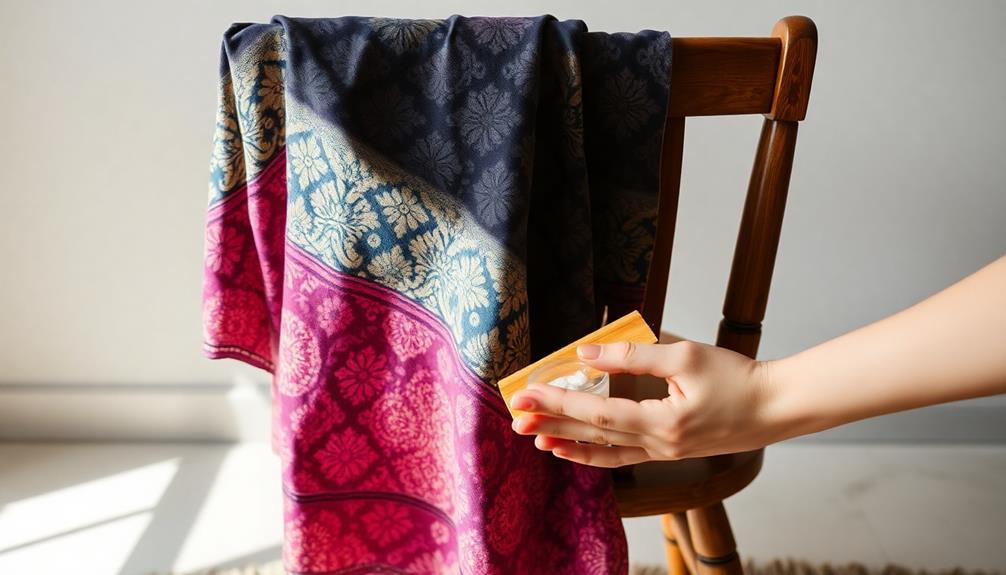
When it comes to caring for your batik, proper washing techniques are key to maintaining those stunning patterns.
To preserve the vibrancy of your batik, consider using gentle detergents and cold water, especially for intricate designs that reflect traditional batik patterns.
You'll want to take extra steps to prevent color bleeding, especially with red fabrics, and keep your pieces looking vibrant.
Additionally, storing and preserving your batik items correctly will guarantee they last for years to come.
Washing Techniques for Batiks
Caring for your batik fabrics is essential to preserving their vibrant colors and intricate designs, especially when considering how these textiles can complement a tropical contemporary house.
By using the right washing techniques, you can maintain their quality and keep them looking stunning for years to come. Here are four tips to help you wash your batik fabrics effectively:
- Separate Wash: Always wash your batik quilts separately in cold water to prevent color bleeding, especially with reds.
- Gentle Cycle: Use a gentle cycle on your washing machine to protect the integrity of the fabric and maintain those high-quality, intricate patterns.
- Mild Detergent: Opt for a mild detergent to help preserve the vibrant colors without causing damage. Avoid bleach, as it can ruin the fabric.
- Air Dry: Whenever possible, air dry your batik items instead of using a machine dryer. This technique helps maintain the fabric's texture and prevents fading.
Preventing Color Bleeding
To keep your batik fabrics looking their best, preventing color bleeding is vital. Start by pre-washing your fabrics in hot water with laundry detergent before dyeing or sewing. This step helps set the colors and reduces the likelihood of color bleeding issues later on.
Opt for high-quality batik fabrics, as they tend to be less prone to shrinkage and maintain their vibrancy even after multiple washes. Additionally, consider incorporating traditional Indonesian design elements into your batik projects to enhance their cultural significance and appeal, as seen in their distinct architectural styles that reflect regional identities.
If you're working with quilts made from red batik fabrics, remember to treat them with extra care since reds are particularly susceptible to bleeding. After finishing your quilt, it's important to give it a thorough wash to guarantee cleanliness and softness. This wash not only stabilizes the colors but also minimizes potential bleeding.
In addition, consider using color catchers during the washing process. These handy tools absorb any loose dyes and help protect the integrity of your batik creations.
Storage and Preservation Tips
Properly storing and preserving your batik fabrics is essential for maintaining their vibrant colors and intricate patterns. Here are some effective tips to help you care for your batik items:
- Store batik fabrics in a cool, dry place, away from direct sunlight to prevent fading and deterioration.
- Use breathable cotton bags or wrap them in acid-free tissue paper to protect them from dust and moisture.
- When storing batik quilts, fold them in loose folds rather than tightly, which helps avoid creasing and damage. Consider using padded hangers if you want to display them.
- Regularly check for wear and inspect your batik items for any signs of damage. Address any issues promptly to extend their life.
Inspiring Batik Decor Ideas
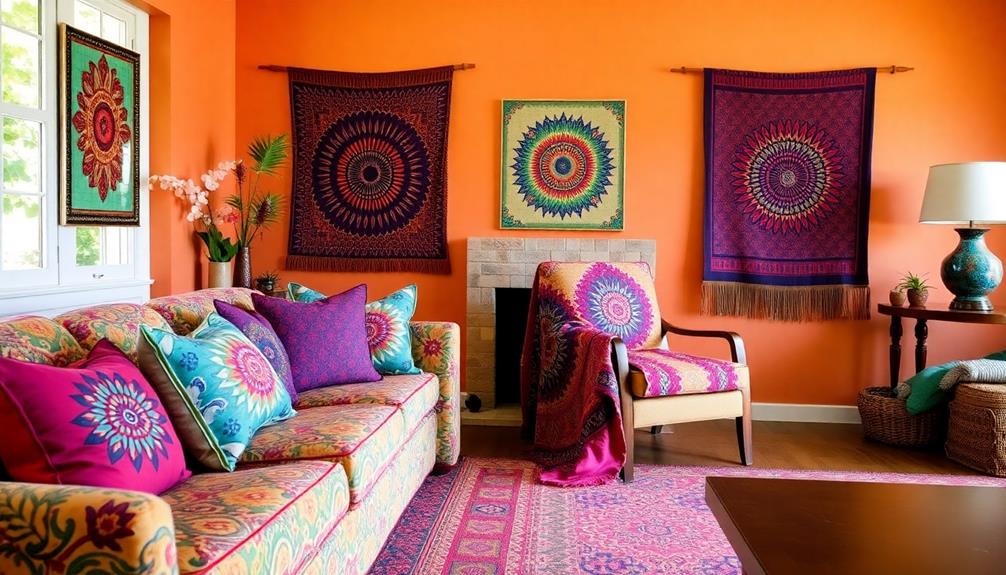
Transforming your space with batik decor can bring a burst of color and cultural richness to your home. Start by incorporating batik fabrics in the form of throws and cushions; these vibrant patterns can serve as focal points that draw the eye.
For a more immersive experience, use batik fabrics for curtains or upholstery, adding a touch of cultural heritage and unique artistry to your living space.
To achieve visual balance, mix batik patterns with solid colors. This guarantees that the striking designs enhance rather than overwhelm the room's overall aesthetic.
Consider displaying batik wall-mounted panels or framed fabric art to create an eye-catching feature wall, showcasing the intricate beauty of these designs.
Explore various batik styles, from traditional motifs to contemporary interpretations. This versatility allows you to find the perfect match for your interior design theme, whether you prefer a modern, bohemian, or eclectic vibe.
Frequently Asked Questions
Can You Quilt With Batiks?
Yes, you can definitely quilt with batiks! Their vibrant colors and unique patterns add depth to your projects. Experiment with different designs and layouts to create stunning quilts that showcase your creativity and style.
How to Set Color in Batik Fabric?
To set color in batik fabric, you'll pre-wash it, apply melted wax for your design, dye it, rinse away excess dye, and finally, remove the wax by ironing between paper towels. Enjoy your vibrant results!
What Is the Batik Method of Fabric Decoration?
The batik method involves applying hot wax to fabric, creating intricate designs before dyeing. You can explore various styles like Batik Tulis, Batik Cap, or Batik Lukis, each showcasing unique artistic expression and cultural significance.
How to Make Batik Patterns?
Did you know that batik dates back over 2,000 years? To make batik patterns, you start by applying hot wax onto fabric, then dye it, and finally remove the wax to reveal stunning designs. Enjoy creating!
Conclusion
By incorporating stunning batik patterns into your space, you'll transform any room from drab to dazzling in the blink of an eye. These vibrant fabrics not only add a unique flair but also tell a story that sparks conversation. Whether you drape them, frame them, or mix them with other textiles, the possibilities are endless. So go ahead, release your creativity and let batik be the showstopper your home has been waiting for!









